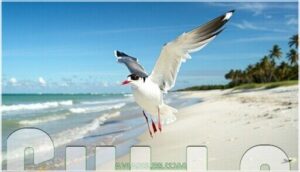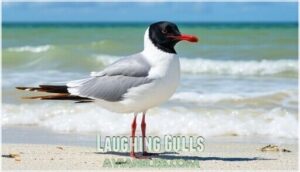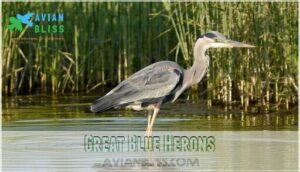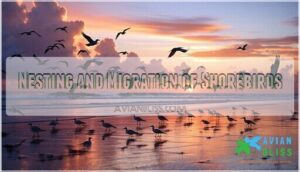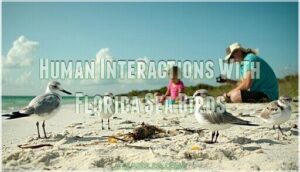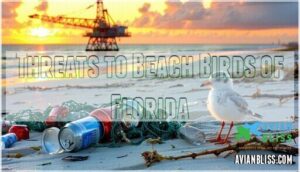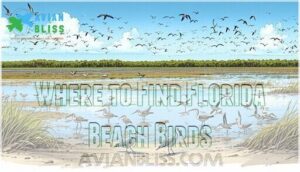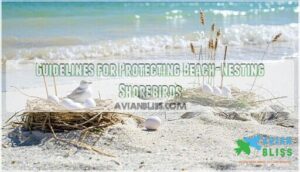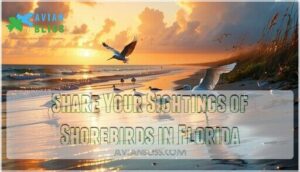This site is supported by our readers. We may earn a commission, at no cost to you, if you purchase through links.
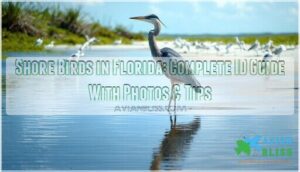 You’ll discover over 40 amazing shore birds in Florida year-round, from tiny Sanderlings that scurry like wind-up toys to massive Brown Pelicans that crash-land into waves.
You’ll discover over 40 amazing shore birds in Florida year-round, from tiny Sanderlings that scurry like wind-up toys to massive Brown Pelicans that crash-land into waves.
Florida’s beaches host everything from chatty Laughing Gulls to graceful Great Blue Herons standing motionless in shallow water.
These coastal birds have mastered beach life – watch Ruddy Turnstones flip rocks like they’re hunting for treasure, or Royal Terns executing perfect fishing dives.
Whether you’re strolling Gulf Coast sands or exploring Atlantic shores, you’ll spot residents and seasonal visitors that make Florida a birder’s paradise.
The secret lies in knowing when and where to look for each species.
Table Of Contents
- Key Takeaways
- Types of Shorebirds in Florida
- Gulls
- Identification Guide to Florida’s Shore and Beach Birds
- Nesting and Migration of Shorebirds
- Human Interactions With Florida Sea Birds
- Threats to Beach Birds of Florida
- Where to Find Florida Beach Birds
- Guidelines for Protecting Beach-Nesting Shorebirds
- Shorebird Species in Florida (with Key Characteristics)
- Share Your Sightings of Shorebirds in Florida
- Frequently Asked Questions (FAQs)
- What are the little birds that run on the beach in Florida?
- What kind of birds fly around the shore?
- What is the black and white shorebird in Florida?
- What is the most common shorebird?
- What do Florida shorebirds eat year-round?
- How do weather patterns affect shorebird behavior?
- Which shorebirds are most endangered in Florida?
- When is peak shorebird watching season?
- How do tides influence shorebird feeding schedules?
- Conclusion
Key Takeaways
- You’ll discover over 80 species of shorebirds along Florida’s coastline year-round, from tiny Sanderlings that chase waves to massive Brown Pelicans diving for fish, making every beach walk a potential birding adventure.
- You can easily identify different species by watching their unique behaviors – Ruddy Turnstones flip rocks, Royal Terns execute perfect fishing dives, and Great Blue Herons stand motionless in shallow water waiting to strike.
- You’ll protect nesting shorebirds by staying at least 300 feet away from marked areas, keeping dogs leashed, properly disposing of trash, and avoiding kite flying near sensitive sites during breeding season from January through September.
- You can find the best shorebird viewing during spring and fall migrations (March-May and September-November) at hotspots like Everglades National Park, Sanibel Island’s J.N. "Ding" Darling refuge, and along the Great Florida Birding Trail‘s 330+ connected sites.
Types of Shorebirds in Florida
Whether you’re a weekend beach walker or serious birder, Florida’s coastline offers an incredible variety of shorebirds to discover.
You’ll find over 80 species calling these waters home, from tiny peeps darting between waves to towering herons standing like statues in the shallows.
Florida’s shores offer a living gallery where 80+ species transform every beach walk into an unforgettable wildlife encounter.
Common shore birds include sandpipers, plovers, yellowlegs, and dowitchers—each with unique traits that make shore bird identification easier once you know what to look for.
Plover identification starts with their distinctive stop-and-go feeding style, while stilt behavior includes their dramatic leg-striking displays.
You’ll notice avocet feeding involves that signature side-to-side bill sweeping, and yellowlegs display their bright legs like neon signs.
Dowitcher habitat preferences lean toward mudflats and shallow pools.
Florida’s location on the Atlantic Flyway makes it a birdwatcher’s paradise.
These Florida shore birds transform ordinary beach walks into exciting treasure hunts for nature lovers.
Gulls
You’ll spot gulls everywhere along Florida’s coast, from busy beaches to quiet fishing piers, and they’re not shy about asking for your lunch.
These smart birds come in several species that range from year-round residents like Laughing Gulls to winter visitors like Ring-billed Gulls.
Each species has distinct markings that make identification easier once you know what to look for, and they are acrobatic birds, making them a joy to watch, with distinct characteristics.
Terns
Terns are the elegant acrobats of Florida’s coastal birds, easily distinguished from their gull cousins by sleek bodies and razor-sharp bills.
You’ll spot Royal Terns with bright orange bills and Caspian Terns flashing blood-red beaks as they dive headfirst into waves.
These seabirds Florida waters host demonstrate remarkable tern behavior through their precise fishing technique—no clumsy scavenging here!
Tern identification becomes easier when you notice their forked tails and pointed wings.
Unfortunately, tern conservation efforts are critical since many species face habitat loss.
Protecting tern habitats along coastlines guarantees these master fishers continue thriving in their specialized tern diet pursuits.
Conservation efforts are also essential for other species, such as the Florida Bonneted Bat, which faces critical habitat designation.
Sanderlings, Dowitchers, and Willets
Beyond the flashy terns, you’ll spot three workhorses of Florida’s shores working the water’s edge with focused determination.
Sanderlings dart like tiny race cars, chasing retreating waves with their characteristic stop-and-go Sanderling Behavior.
Short-Billed Dowitchers and Long-Billed Dowitchers probe mudflats like living sewing machines, their Dowitcher Diet consisting of marine worms and small crustaceans.
Willets patrol diverse Willet Habitat from beaches to marshes, their Conservation Status remaining stable despite coastal pressures.
- Sanderlings rank among the most abundant wintering shorebirds along Florida’s coast
- Dowitchers show remarkable Plumage Variation between their rusty breeding and gray winter coats
- These resilient shorebirds adapt to both natural shorelines and developed waterfront areas
Herons and Egrets
Moving from the sandy shoreline hunters, Florida’s elegant wading birds command shallow waters with grace.
You’ll spot these patient stalkers standing motionless before striking with lightning speed.
Great Blue Herons hunt solo, while Great Egrets gather in colony nesting sites.
Snowy Egrets display brilliant white egret plumage, contrasting with Little Blue Heron’s slate coloring.
Juvenile herons often appear completely white before developing adult colors.
Their diverse heron diet includes fish, frogs, and crustaceans.
Great Egrets, belonging to the Ardea genus, have a debated taxonomic history.
| Species | Key Features |
|---|---|
| Great Blue Heron | Large size, blue-gray plumage, white throat stripe |
| Great Egret | All-white, yellow bill, black legs, elegant neck |
| Snowy Egret | Bright white, black bill, distinctive golden feet |
| Little Blue Heron | Slate blue adults, white juveniles, dark-tipped bill |
Other Florida Beach Birds
Florida’s beaches host some truly spectacular birds that’ll make you do a double-take.
The Roseate Spoonbill’s bright pink color comes from its spoonbill diet of crustaceans and small fish – the more shrimp they eat, the pinker they get!
You’ll spot American Oystercatchers using oystercatcher feeding techniques, prying open shellfish with their brilliant orange bills during low tide.
Black Skimmers showcase fascinating skimmer behavior, flying low with their knife-like lower bill slicing through water to catch fish.
Brown Pelicans demonstrate impressive pelican hunting skills, diving headfirst from 30 feet up.
Don’t forget about flamingos – their flamingo origins trace back to escaped captive birds that established wild populations.
These coastal birds Florida offers make every beach walk an adventure for Florida birding enthusiasts seeking unique shorebirds and beach birds Florida calls home.
Identification Guide to Florida’s Shore and Beach Birds
You’ll find identifying Florida’s shore birds gets easier once you know the key features to look for, like bill shape, leg color, and size differences.
We’ll walk you through the most common species you’ll spot along Florida’s beaches, from the loud laughing gulls that might steal your sandwich to the majestic great blue herons standing perfectly still in shallow water.
Laughing Gulls
You’ll spot Laughing Gulls easily with their signature black hoods and red beaks dotting Florida’s coastlines.
These vocal coastal birds Florida residents know well display distinct plumage variations throughout seasons.
- Black hood covering entire head during breeding season
- Bright red-orange bill and matching legs
- Gray wings contrasting with pure white underparts
- Distinctive laughing call echoing across beaches
Their social behavior and opportunistic Laughing Gull diet make them fearless around beachgoers during Florida birding adventures.
Herring Gulls
Unlike their laughing cousins, Herring Gulls sport a more serious demeanor with their pale gray backs and yellow eyes.
Their harsh calls dominate Gull Vocalizations near fishing piers.
These Arctic breeders winter along Florida’s coast, where their Herring Gull Diet includes fish, crabs, and beach scraps.
Watch their Gull Social Behavior as they aggressively compete for food.
Despite Herring Gull Conservation concerns, these adaptable seabirds thrive in diverse Herring Gull Habitat from beaches to parking lots.
Ring-billed Gulls
These common winter visitors sport a distinctive black band around their yellow bills, making gull identification straightforward among Florida’s shorebirds.
Ring-billed gulls arrive from northern breeding grounds, showing subtle plumage variation between adults and juveniles.
Their winter behavior includes scavenging beaches, parks, and parking lots with remarkable adaptability. The Florida population swells dramatically during cooler months as these resourceful gulls expand their ring-billed diet beyond fish to include scraps, insects, and marine invertebrates found along coastlines.
Pelicans
You’ll recognize Brown Pelicans by their massive pouched bills and distinctive plunge-diving technique.
These coastal birds demonstrate remarkable pelican behavior, tucking their wings back before hitting water to catch fish.
Their pelican diet consists mainly of small fish, while pelican conservation efforts helped restore populations after DDT nearly wiped them out decades ago.
The New Orleans basketball team was rebranded as Pelicans in 2013.
Great Blue Herons
Standing motionless like a feathered statue, the Great Blue Heron commands respect along Florida’s waterways.
You’ll recognize this impressive wading bird by its slate-blue plumage, white throat stripe, and distinctive S-curved neck.
These patient hunters can remain still for ages before striking with lightning speed.
Their heron diet consists mainly of fish, frogs, and small reptiles found in shallow waters.
Florida bird species like this thrive in diverse heron habitats from coastal marshes to inland ponds, making heron conservation efforts essential for maintaining healthy ecosystems.
Nesting and Migration of Shorebirds
You’ll discover that Florida’s shorebirds follow some of the world’s most amazing travel routes, with many species flying thousands of miles between their Arctic breeding grounds and southern wintering spots.
Understanding when these feathered marathoners arrive, where they nest, and how they raise their young will help you spot them at exactly the right times during your beach walks.
Shorebirds Life Cycle
Florida’s shorebirds live fascinating lives that’ll amaze you.
From egg incubation to juvenile survival, these birds face incredible challenges. Their breeding cycles span months, with some species attempting multiple nests per season. Understanding their lifespan factors helps you appreciate what they endure.
Here’s what makes their life cycle remarkable:
- Egg Incubation takes 18-30 days depending on species
- Chick Development happens rapidly with precocial young
- Fledgling Stage occurs throughout summer until August
- Juvenile Survival depends heavily on habitat protection
Each stage requires specific nesting conditions and minimal human disturbance for success.
Shorebirds Migration
Twice yearly, millions of shorebirds transform Florida into a bustling migration highway.
You’ll witness incredible journeys as birds follow the Atlantic and Mississippi flyways between Arctic breeding grounds and South American wintering areas.
Migration patterns reveal critical stopover sites where exhausted travelers refuel.
Climate impacts and habitat loss create serious migration threats, making conservation efforts essential.
Time your visits during peak migration seasons—spring and fall—when Florida’s shores become nature’s ultimate rest stop.
Shorebirds Nesting
While these remarkable migrants prepare for their next journey, they’re also busy creating the next generation right here on Florida’s shores.
Shorebirds transform from travelers into devoted parents during breeding season, which runs from January through September.
Most species choose open sandy beaches and coastal marshes as their nesting habitats, where they scrape shallow depressions in the sand.
Here’s what makes their parental care so remarkable:
- Both parents take turns incubating eggs for weeks, never leaving them unprotected
- Tiny chicks must learn to find food within hours of hatching
- Families face constant nesting threats from predators, storms, and human disturbance
Their nesting success depends entirely on our respect for posted areas and keeping dogs leashed during chick development season.
Human Interactions With Florida Sea Birds
You’ve probably noticed how gulls boldly snatch snacks from your beach picnic or watched pelicans eyeing your fishing catch with hopeful interest.
While these encounters can be entertaining, your actions around Florida’s shore birds directly affect their health and survival, especially regarding trash disposal and helping injured birds.
Litter’s Impact on Birds
Plastic debris transforms paradise into peril for Florida’s shorebirds.
When these coastal birds mistake colorful trash for food, plastic ingestion blocks their digestive systems, leading to starvation.
Entanglement hazards from fishing lines and nets cause injury or death.
Chemical exposure from degrading plastics enters their food chain, while microplastic effects accumulate over time.
| Pollution Threat | Impact on Shorebirds |
|---|---|
| Plastic Ingestion | Digestive blockage, starvation |
| Entanglement Hazards | Injury from fishing gear |
| Habitat Degradation | Loss of feeding grounds |
| Chemical Exposure | Toxins in food chain |
| Microplastic Effects | Long-term health issues |
Your beach cleanup efforts directly protect these vulnerable coastal areas from mounting threats.
Dealing With Injured Birds
Beyond litter hazards, you’ll inevitably encounter injured birds along Florida’s coastlines. When you spot a wounded shorebird, your first instinct might be to help directly, but resist that urge. Instead, contact local bird rehabilitation centers immediately—they have the expertise and permits to handle Florida wildlife safely.
These rescue organizations provide proper first aid and veterinary care that untrained hands simply can’t match. Many resources are available for injured bird assistance.
Here’s your action plan for bird rescue situations:
- Keep your distance and observe the bird’s condition from afar
- Document the location, species, and type of injury for reporting injuries
- Call certified wildlife rehabilitators rather than attempting DIY rescue
Remember, injury prevention through bird conservation efforts protects more birds than emergency interventions ever could, and it’s essential to handle situations with proper care and expertise to ensure the best outcomes for the birds.
Threats to Beach Birds of Florida
Florida’s shorebirds face mounting pressures that threaten their survival along our coastlines.
Human Disturbance tops the list – your beach walks, kite flying, and unrestrained pets can force birds to abandon nests or exhaust energy avoiding people.
Habitat Loss accelerates as coastal development eliminates vital nesting grounds, while rising seas from Climate Change flood remaining sites.
Pollution Impact extends beyond visible trash.
Chemical runoff affects food sources, and plastic debris tricks birds into feeding harmful materials to chicks.
Sadly, plastic pollution impacts even remote bird habitats.
Predation Risks increase when human activity attracts cats, raccoons, and rats to nesting areas.
| Threat Category | Primary Impact | Prevention Action |
|---|---|---|
| Human Activity | Nest abandonment | Stay 300+ feet away |
| Unrestrained Pets | Chick mortality | Keep dogs leashed |
| Coastal Development | Habitat destruction | Support protected areas |
| Pollution | Food contamination | Pack out all trash |
| Climate Change | Rising sea levels | Reduce carbon footprint |
These threats compound each other, making Florida’s beach birds increasingly vulnerable to population decline.
Where to Find Florida Beach Birds
You’ll find Florida’s beach birds in predictable spots where shallow water meets sandy shores, mudflats, salt marshes, and coastal wetlands throughout the state.
Think of places like Everglades National Park, Sanibel Island, and St. Petersburg’s beaches where these feathered residents gather to feed, nest, and show off their fishing skills year-round.
Beach-Nesting Shorebirds
Along Florida’s sandy coastlines, beach-nesting shorebirds face tough survival odds.
These resilient birds choose open sand for their homes, making chick survival a daily challenge.
- Nesting Habitats – Open beaches provide essential breeding grounds
- Predator Control – Parents defend against cats, raccoons, and gulls
- Conservation Challenges – Human disturbance threatens success rates
- Parental Care – Both adults share feeding duties
Bird conservation efforts focus on protecting these vulnerable Florida beaches.
Notable Birding Locations
Looking for the best spots to catch sight of Florida’s amazing shore birds? You’re in luck! The state’s coastal hotspots offer incredible birdwatching in Florida opportunities year-round.
Start with Everglades National Park, where over 330 bird species call home – Anhinga Trail and Paurotis Pond are must-visit spots. Florida birdwatching hotspots like J.N. "Ding" Darling National Wildlife Refuge on Sanibel Island rank among the nation’s top destinations.
Don’t overlook inland sanctuaries either. Corkscrew Swamp Sanctuary provides excellent shorebirds Florida viewing away from the coast. The Great Florida Birding Trail connects over 330 sites statewide, making navigation between birding hotspots Florida simple.
Seasonal variations affect bird populations, so spring and fall migrations offer spectacular viewing. Most locations consider accessibility factors, featuring boardwalks and viewing platforms perfect for spotting Florida shorebirds without disturbing their habitat.
Many options exist for guided Florida excursions.
Guidelines for Protecting Beach-Nesting Shorebirds
You can make a real difference for Florida’s beach-nesting birds by following simple guidelines that protect their homes and families.
These easy steps help guarantee that plovers, terns, and skimmers can raise their chicks successfully without the stress of human interference or pet disturbances.
Coastal Development and Nesting Areas
Coastal development poses the greatest threat to Florida’s shorebirds, destroying nesting habitat faster than conservation strategies can protect it.
Beach erosion from construction removes critical protected areas where birds raise their young.
You can help by supporting these conservation efforts:
- Advocate for buffer zones between development and nesting sites
- Support organizations fighting habitat loss through legal channels
- Choose eco-friendly accommodations that respect coastal areas
Smart planning keeps bulldozers away from sensitive nesting disturbance zones, giving our feathered friends space to thrive, and this is crucial for conservation efforts, as it helps in protecting habitat and supporting eco-friendly practices.
Human Disturbance and Nest Exposure
Beyond managing where structures go, protecting nesting shorebirds requires controlling human activity near sensitive sites.
Even well-meaning beachgoers can trigger catastrophic nest abandonment when they unknowingly wander too close to camouflaged eggs.
Your footsteps might seem harmless, but they’re giant earthquakes to ground-nesting birds.
When startled parents flee, eggs become vulnerable to Florida’s scorching sun and opportunistic predators.
Beach closures during peak nesting seasons aren’t about ruining your vacation—they’re about ensuring nesting success for species already facing habitat degradation.
| Human Activity | Impact on Nesting Birds | Conservation Response |
|---|---|---|
| Walking near nests | Causes immediate abandonment | Establish buffer zones |
| Beach recreation | Disrupts feeding patterns | Implement seasonal restrictions |
| Photography attempts | Triggers stress responses | Require telephoto distance limits |
| Large group gatherings | Creates overwhelming disturbance | Designate quiet zones |
| Night activities | Interferes with nocturnal behaviors | Enforce dusk-to-dawn protection |
Disturbance mitigation starts with awareness.
These coastal areas serve as nurseries for threatened species, where predator introduction through human presence can devastate entire colonies.
Simple respect creates safe havens where Florida’s remarkable shorebirds can thrive.
Dog and Cat Restrictions
Unrestrained pets spell disaster for Florida’s shorebirds.
Your furry friends trigger panic flights, abandoning precious eggs and chicks to predators.
Pet Leash Laws in Protected Areas aren’t suggestions—they’re lifelines for vulnerable species.
Follow these Wildlife Disturbance prevention steps:
- Keep dogs leashed in Designated Zones near bird habitats Florida
- Prevent Fecal Contamination on coastal areas and beaches
- Maintain distance from nesting shorebirds
Trash Disposal and Predators
Proper waste management protects Florida’s shorebirds from deadly threats. When you leave trash scattered, you’re rolling out the welcome mat for raccoons, cats, and rats that raid nests. These predators devastate bird populations through nest predation. Plastic ingestion kills adults and chicks who mistake colorful debris for food. Habitat degradation follows when litter accumulates.
| Trash Type | Attracts These Predators | Impact on Shorebirds |
|---|---|---|
| Food scraps | Raccoons, gulls, crows | Nest raids, chick mortality |
| Plastic bags | Rats, feral cats | Plastic ingestion, entanglement |
| Beverage containers | Ants, flies, rodents | Disease transmission, pollution |
| Fish bait/tackle | Larger birds, mammals | Habitat degradation, injury |
| General litter | Multiple species | Ecosystem disruption, stress |
Predator control starts with you—secure trash in covered bins and pack out everything you bring. Consider investing in a secure trash receptacle to further minimize risks. This approach helps in protecting the shorebirds and their habitats from the harmful effects of pollution and predation. By taking these steps, you can contribute to the conservation of Florida’s shorebirds and help maintain a healthy ecosystem.
Kite Flying and Aggravated Birds
Flying kites near nesting shorebirds creates serious problems.
Kite proximity causes nesting disruption as birds mistake colorful objects for predators. The noise pollution from flapping kites triggers panic flights, abandoning eggs or chicks.
Bird strikes can occur when frightened birds flee erratically. Many Florida beaches enforce seasonal bans during nesting periods.
Watch for agitated bird behavior and immediately stop kite activities to prevent these bird threats during critical human interactions, especially to avoid nesting disruption and ensure the safety of the birds, which can be achieved by being aware of panic flights.
Rooftop Nesting and Beach Driving
Several Florida shorebirds have adapted to rooftop nesting as beaches become busier, but vehicle impacts still threaten their success.
When you’re driving near coastal areas, maintain driving setbacks of at least 300 feet from marked nesting zones. Slow speeds under 15 mph prevent sand spray that damages eggs and chicks.
Rooftop materials like gravel mimic natural habitat, yet vibrations from nearby traffic stress parent birds.
You’ll help habitat restoration efforts by choosing alternate routes during peak nesting season, giving these resilient birds the peaceful space they desperately need to thrive and have a better chance of survival in their natural habitat.
Shorebird Species in Florida (with Key Characteristics)
When you’re exploring Florida’s coastlines, you’ll encounter fascinating shorebird species that each tell their own story through unique characteristics.
These birds have evolved remarkable adaptations that make bird identification both exciting and rewarding for Florida birds enthusiasts.
Here are five key shorebird species to watch for:
- Semipalmated Plovers – Look for their distinctive single black breast band and orange legs during Plover Identification
- Black-necked Stilts – Notice their incredible Stilt Adaptations with needle-like bills and bright pink legs
- American Avocets – Observe their specialized Avocet Feeding technique, sweeping upturned bills side-to-side
- Greater Yellowlegs – Watch their active Yellowlegs Behavior as they wade through shallow waters
- Short-billed Dowitchers – Find them in their preferred Dowitcher Habitat of mudflats and marshes
Each bird species offers clues through size, coloring, and behavior patterns that make Florida shorebirds identification manageable once you know what to look for.
Share Your Sightings of Shorebirds in Florida
Spotted something special during your Florida shorebird adventures? Your sightings matter more than you might think! Every photograph and observation helps scientists track bird behavior, habitat changes, and migration patterns across the state’s coastlines.
Share your discoveries with eBird, iNaturalist, or local Audubon chapters. These platforms turn your casual birdwatching into valuable conservation efforts. Got a rare sighting? Document it with clear photos and detailed notes about location, weather, and what the birds were doing.
Photography tips for better documentation: shoot during golden hour, focus on distinctive features like bill shape and leg color, and capture birds in their natural habitat. Even common species provide important data about population trends.
Join Florida bird conservation groups online to connect with fellow enthusiasts. Your backyard egret or beach sandpiper observation contributes to protecting these remarkable species for future shore bird migration seasons.
Frequently Asked Questions (FAQs)
What are the little birds that run on the beach in Florida?
About 81 shorebird species call Florida home.
Those tiny speedsters you’re watching are likely Sanderlings – small white birds that dart along the shoreline in groups, chasing waves while hunting for tasty morsels.
What kind of birds fly around the shore?
You’ll see gulls swooping overhead, terns diving for fish, and pelicans gliding just above the waves.
These coastal flyers patrol Florida’s shores constantly, hunting for food and riding the ocean breezes with effortless grace.
What is the black and white shorebird in Florida?
You’ll likely encounter the Black-necked Stilt, with its striking black back and white belly, plus those impossibly long pink legs.
There’s also the American Oystercatcher, sporting a bold black head contrasting beautifully with its white underparts, which can be considered a key feature alongside the Black-necked Stilt.
What is the most common shorebird?
While many assume exotic species dominate, you’ll actually spot the humble Sanderling most often.
These winter visitors blanket Florida’s beaches in white plumage, scurrying in small flocks along the water’s edge like tiny beach cleaners.
What do Florida shorebirds eat year-round?
You’ll find Florida’s shorebirds munching on a smorgasbord throughout the year: small fish, crabs, worms, insects, mollusks, and crustaceans.
They’re opportunistic feeders who adapt their diet based on what’s available in their coastal buffet.
How do weather patterns affect shorebird behavior?
Weather patterns dramatically influence when you’ll spot shorebirds feeding, migrating, and nesting.
Storms push birds inland, while calm conditions bring them to beaches.
Cold fronts trigger massive migrations, creating perfect birdwatching opportunities.
Which shorebirds are most endangered in Florida?
You’ll find that American Avocets face the biggest threats from pollution like selenium and mercury.
Semipalmated Plovers have declined from overhunting and oil spills, while climate change impacts their nesting sites.
When is peak shorebird watching season?
Nature’s feathered performers put on their best show during fall and spring migrations – typically September through November and March through May.
You’ll spot the most diverse cast of characters when weather conditions create perfect traveling days.
How do tides influence shorebird feeding schedules?
Tides dictate your shorebird watching schedule perfectly.
You’ll spot the most action during low tide when mudflats expose tasty invertebrates.
High tide pushes birds to roost areas, making them easier to find but less active, which is related to the overall tide schedule.
Conclusion
Florida’s coastline is like a living runway show where shore birds in Florida strut their stuff year-round.
You’ve now got the tools to identify these feathered performers, from tiny sandpipers to majestic herons.
Remember to keep your distance, respect nesting areas, and always pack binoculars for the best views.
Whether you’re a beginner or seasoned birder, Florida’s beaches offer endless opportunities to observe these incredible coastal creatures in their natural habitat.
- https://www.gsa.state.al.us/apps/CAGDV/Metadata/Biological/Florida_Shorebird_Database.html
- https://edis.ifas.ufl.edu/publication/UW493
- https://www.nrs.fs.usda.gov/pubs/gtr/gtr_ne160/gtr_ne160_061.pdf
- https://www.charlottecountyfl.gov/departments/community-services/natural-resources/beach-nesting-birds.stml
- https://www.shorebirdplan.org/wp-content/uploads/2013/01/USShorebirdPlan2Ed.pdf

